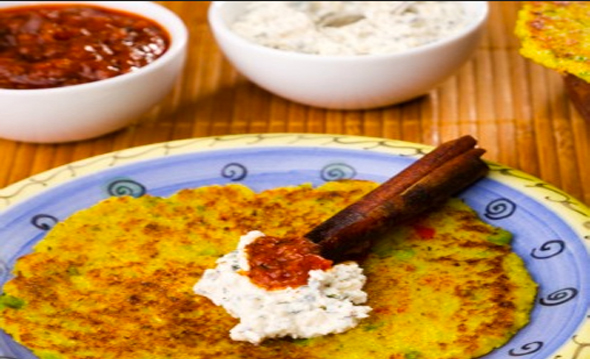Mama’s Punjabi Recipes: Daal De Poode (Lentil Flatcakes)
There are many ways to eat daal and not just with roti (flatbread) or chawal (rice). Some people will fry it, then mix in some spices and eat it dry like a snack. Others make a thick soup with rice and eat it like khichaddi (watery daal and rice), eaten often when one has an upset stomach or feels ill. Others grind the daal into a coarse powder and make bhallas (lentil donuts) to soak into yogurt.
An Indian meal just feels incomplete without some type of daal, even if you aren’t vegetarian. Daal contains 3.5 times the protein of rice and 2.5 times that of wheat. It is typically around 25% protein by dry weight, but when cooked daal contains only 9% protein, 70% water, 20% carbohydrates and 1% fat. As extra water is added to cooked daal, like in sambar, the proportions of proteins and other nutrients will be further reduced.
And there is yet still another way to eat daal; make it into a pooda (flatcake) as Punjabis call it, or chilla as Gujaratis call it. It is made of the split green chilkewali moong daal or the whole green moong daal, first soaked and then ground into a medium coarse paste. The only difference is that the whole green moong daal must be soaked overnight.
The paste is then mixed with spices and then poured onto a tava or flatplate and cooked into a 6-inch round, ¼ inch thick pancake. Once cooked, these poode are eaten with chutney or achaar or for young people, even with ketchup! Just like with pakoras (fried fritters), poode taste great on a rainy day, with warm tea. Poode can be a snack, but a really filling one as you can’t resist eating only one!
Ingredients:
2 cups moong daal (split moong lentils with skin or whole moong lentils)
4 cups garam pani (warm water)
½ cup besan (yellow gram flour)
2 tbspn olive oil
1 medium adrak (ginger) – peeled and chopped or use powdered ginger
1 small piyaaz (onion) – peeled and chopped
2 hari mirch (long green chillies) – ends cut and chopped
Spices: lal mirch (red pepper); namak (salt) – to your taste
Directions:
1. Place the moong dal in a bowl, wash it thoroughly in cold water.
2. If the moong daal is the whole type, then let it soak in 4 cups of warm water overnight not in the fridge. If it is the split moong lentils with skin, then let it soak in 4 cups of warm water for a minimum of 6 hours.
3. Gently pour the daal with the water into an electric grinder a little at a time and run it till the daal becomes a paste. Scoop out into a bowl and repeat till all the daal is done.
4. With the last batch of daal, throw in the onions, ginger and chillies and grind together.
5. Pour all the ground up daal in the bowl, add in the besan and mix thoroughly. Now add the salt and red pepper to your taste.
6. Pre-heat a tava (flatplate) or non-stick frying pan over high heat and then turn it down to medium. Sprinkle a half teaspoon of oil to coat the tava, then pour the mixture with a large spoon and spread to make it 6 inches round.
7. When small holes appear in the pancake, gently flip it over with a spatula. Sprinkle a little oil around the edges and let it cook till it is slightly brown on both sides. Keep to the side on a large plate and repeat till all the mixture is done.
8. Serve with chutney or achaar (pickles) of your choice.
MAMA’S TIP OF THE WEEK
TO REDUCE SPLATTER, USE A WIDE RIMMED PAN TO COOK DAALS
One big complaint from many people is that cooking daals – especially moong daal – always messes up their cooktops as they boil over and spill out of the pot. The main reason for that is that they want to cook the daal quickly and so place it over high heat. The proper thing to do is cook the daal initially on medium high heat; then when it appears like it will start to boil, reduce the heat to low and let the daal simmer. Of course, this still requires you to keep an eye on the daal!
One sure-fire way to avoid having the daal spill over is to cook it in a wide rimmed pot or preferably deep frying pan or a kadai (wok). The wide face allows the heat to dissipate and the daal never gets a chance to form an air dome that will rise up and spill over.

Shakuntla Malhotra is a skilled cook of Punjabi dishes made in the old-fashioned style that she learnt as a young woman in her ancestral home in Lyallpur (since renamed Faisalabad), India before it became part of Pakistan after the Partition in 1947. People have often admired her cooking for its simplicity and taste that comes with each mouthful. Even in her mid-eighties, she continues to cook daily and agreed to share some of her delectable Punjabi recipes.

